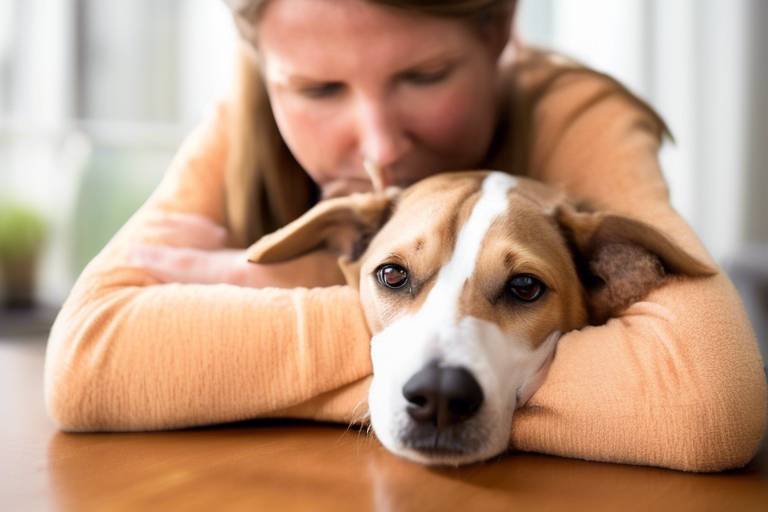How to Help Your Pet with Separation Anxiety
Separation anxiety in pets can be a heart-wrenching experience for both the furry friend and their owner. Just imagine coming home to a house that looks like a tornado hit it, or hearing your pup's mournful howls echoing through the neighborhood. It's tough, right? But don't worry! With a little understanding and some effective strategies, you can help your beloved pet feel more secure and comfortable when you're away.
First off, it's essential to recognize that separation anxiety is a common issue among pets, especially dogs. It's not just about being a little sad when you leave; it can lead to a range of distressing behaviors. When your pet feels anxious, they might bark excessively, chew on furniture, or even refuse to eat. This isn't just annoying; it can also be damaging to their health and well-being. So, what can you do to ease their anxiety? Let's dive into some practical solutions!
One of the most effective ways to help your pet cope with separation anxiety is to create a safe and comforting environment. Imagine this as their personal sanctuary where they can retreat and feel secure. You can achieve this by providing comfort items like their favorite blanket or a plush toy that smells like you. These familiar scents can have a calming effect, making them feel more at ease when you’re not around.
Another critical aspect is establishing a designated safe zone within your home. This area should be quiet and free from distractions, allowing your pet to unwind. Think of it as their own little fortress of solitude. You might want to include their bed, some toys, and maybe even a piece of your clothing to provide that extra sense of comfort.
Now, let’s talk about gradual desensitization. This technique involves slowly getting your pet accustomed to being alone. You can start with short absences, perhaps just stepping out for a few minutes, and gradually increase the duration. This approach helps build their confidence and reduces anxiety over time. It's like training for a marathon; you don't just run 26 miles on your first day!
Positive reinforcement is another powerful tool in your arsenal. When your pet remains calm during your absence, reward them with treats or praise. This helps them associate being alone with positive experiences. Over time, they’ll learn that your departures aren’t something to fear but rather an opportunity for a tasty treat or a fun surprise when you return.
However, if your pet's separation anxiety is severe, it may be time to seek professional help. A veterinarian or animal behaviorist can provide tailored strategies and, if necessary, medications to assist with anxiety. Behavioral therapy can also be incredibly effective. Professionals can guide you through structured programs designed to help your pet cope better with being alone.
In conclusion, helping your pet with separation anxiety requires patience, understanding, and a few strategic actions. By creating a safe environment, gradually desensitizing them to your absences, and possibly seeking professional guidance, you can significantly improve their quality of life. Remember, your pet relies on you for support, and with your help, they can learn to feel secure even when you’re not home.
- What are the common signs of separation anxiety in pets? Common signs include excessive barking, destructive behavior, and inappropriate elimination.
- How can I create a safe space for my pet? Provide comfort items and establish a quiet area in your home where they can retreat.
- Is medication necessary for my pet's separation anxiety? In severe cases, consulting with a veterinarian may lead to medication options, but behavioral strategies are often effective.
- How long does it take to see improvement? Every pet is different, but with consistent efforts, you may start to see changes within a few weeks.

Understanding Separation Anxiety
Separation anxiety in pets is more common than you might think. It's that feeling of distress that pets experience when they are left alone or separated from their owners. Just like humans, animals can feel lonely and anxious, and this emotional turmoil can lead to various behavioral issues. Imagine how you would feel if your best friend suddenly disappeared for hours on end—your pet experiences a similar sense of loss and confusion.
Recognizing the signs of separation anxiety is crucial for pet owners. If you’ve ever come home to find your favorite pair of shoes chewed to bits or your living room turned into a makeshift dog park, you might be witnessing the effects of your pet’s anxiety. This condition can manifest in several ways, and understanding these behaviors can help you take proactive measures to support your furry friend.
Many pets, especially dogs, thrive on companionship and routine. When their daily schedule is disrupted, or they are left alone for an extended period, they can become anxious. This anxiety can lead to a cycle of stress that not only affects your pet but can also disrupt your household. It's essential to recognize that separation anxiety is not a behavioral flaw; rather, it's a genuine emotional response to their environment.
Some common signs of separation anxiety include:
- Excessive barking or howling: This is often a cry for help, as your pet may be calling out for you.
- Destructive behavior: Chewing furniture or digging at doors can indicate frustration and anxiety.
- Inappropriate elimination: Accidents in the house can be a sign that your pet is too stressed to hold it in.
By understanding the underlying causes of separation anxiety, you can create a plan to help your pet cope better when you are away. It's about building their confidence and teaching them that being alone isn't something to fear. Remember, patience and empathy are key—just as you would comfort a friend going through a tough time, your pet needs the same understanding from you.

Identifying Symptoms
When it comes to separation anxiety in pets, being observant is key. Many pet owners might not realize that their furry friends are struggling until the symptoms become pronounced. Recognizing these symptoms early can make a significant difference in addressing the issue effectively. Common signs of separation anxiety include excessive barking, destructive behavior, and inappropriate elimination. But there’s much more to it than just these obvious indicators. Let's dive deeper into the various symptoms that pet owners should be on the lookout for, so they can take action before the situation escalates.
It's important to note that pets can express their anxiety in different ways. For instance, a dog might bark incessantly when left alone, while a cat might resort to knocking things off shelves in a fit of frustration. Understanding these behaviors is crucial for effective intervention. Here are some of the most common behavioral signs:
- Pacing: If you notice your pet walking back and forth in a confined space, it could indicate they're feeling anxious.
- Whining or howling: Vocalizations can be a cry for help, signaling distress when they realize you're leaving.
- Drooling: Excessive drooling can be a physical manifestation of anxiety.
Beyond these behavioral cues, pets may also show physical symptoms that indicate their emotional state. For example, trembling or shaking can be a telltale sign of fear. Additionally, some pets might engage in excessive grooming, which can lead to skin irritations or even bald patches. These indicators can help you gauge the severity of your pet's anxiety, allowing you to take the necessary steps to help them feel more comfortable.
Another critical aspect to consider is the long-term effects of untreated separation anxiety. If left unaddressed, it can lead to more severe behavioral issues, which can affect both your pet's health and your own peace of mind. Pets might develop a habit of destructive behavior, leading to costly damages in your home. Early intervention is essential to prevent escalation and to promote a happier, healthier life for your furry companion.
Emotional signs also play a significant role in identifying separation anxiety. You may notice your pet being overly clingy or displaying fearfulness when you prepare to leave. This emotional distress can manifest in various ways, such as following you around the house or hiding when they sense you’re about to go out. Recognizing these signs can guide you in providing the right support and comfort to help your pet cope with their anxiety.
In summary, being aware of the symptoms of separation anxiety in pets is crucial for any pet owner. By recognizing the behavioral, physical, and emotional signs, you can take proactive measures to alleviate your pet's distress and ensure a smoother transition when you are away. Remember, your furry friend relies on you to create a safe and secure environment, and understanding their needs is the first step in providing the comfort they deserve.
Q: What should I do if I suspect my pet has separation anxiety?
A: Start by observing their behavior when you leave and return home. If you notice signs of anxiety, consider implementing gradual desensitization techniques or consulting a veterinarian for advice.
Q: Can separation anxiety be cured?
A: While it may not be entirely "cured," many pets can learn to cope with their anxiety through training, behavioral therapy, and, if necessary, medication.
Q: How long does it take for a pet to adjust to being alone?
A: The adjustment period varies for each pet. Some may adapt quickly, while others might take weeks or even months. Patience and consistency are key.
Q: Are certain breeds more prone to separation anxiety?
A: Yes, some breeds, particularly those that are more social or have a strong attachment to their owners, may be more susceptible to separation anxiety.
Behavioral Signs
This article explores effective strategies and techniques to alleviate separation anxiety in pets, ensuring a smoother transition when you are away and promoting their overall well-being.
Separation anxiety in pets can manifest through various behaviors. By recognizing the signs, pet owners can take proactive measures to help their furry companions cope better during their absence.
Common symptoms of separation anxiety include excessive barking, destructive behavior, and inappropriate elimination. Knowing these signs helps owners address the issue promptly and effectively.
When it comes to understanding your pet's emotional state, paying attention to their is crucial. Pets often communicate their feelings through specific actions, especially when they are experiencing anxiety due to separation. Here are some key behaviors to look out for:
- Pacing: If you notice your pet walking back and forth, it could indicate restlessness and anxiety.
- Whining or Barking: Excessive vocalizations are often a cry for help, signaling distress when left alone.
- Destructive Behavior: Chewing furniture, scratching doors, or knocking over items can be signs that your pet is trying to cope with their anxiety.
- Drooling: Increased salivation can be a physical manifestation of their stress levels.
Recognizing these behavioral cues early on can significantly impact how effectively you can intervene. For example, if your pet is pacing or whining, it might be time to consider changes in their routine or environment. Just like humans, pets can feel overwhelmed, and understanding their behavior can lead to effective solutions.
Moreover, these signs can vary in intensity. A pet that usually enjoys being independent may suddenly become clingy or exhibit signs of distress. This shift can indicate a deeper emotional issue that needs attention. Therefore, it's essential to observe your pet's usual behavior and note any changes. Just like a child might throw a tantrum when left with a babysitter, your furry friend may express their discomfort in similar ways.
In addition to behavioral signs, pets may show physical symptoms like trembling or excessive grooming. These indicators can help owners identify the severity of the anxiety.
Untreated separation anxiety can lead to long-term behavioral issues, affecting both the pet's health and the owner's peace of mind. Early intervention is essential to prevent escalation.
Pets may also display emotional distress through clinginess or fearfulness. Recognizing these emotional signs can guide owners in providing the right support and comfort.
Designing a comforting environment can significantly reduce a pet's anxiety levels. A safe space can help pets feel secure when left alone, minimizing stress.
Providing comforting items like blankets or toys can help ease anxiety. Familiar scents and textures can create a sense of security for pets during your absence.
Establishing a designated safe zone within the home can provide pets with a retreat. This area should be quiet and free from distractions, promoting relaxation and comfort.
Gradual desensitization involves slowly acclimating pets to being alone. This technique can help reduce anxiety over time, making separations less stressful for both pets and owners.
Start with short periods of separation to help pets adjust. Gradually increasing the duration can build their confidence and reduce anxiety during longer absences.
Using positive reinforcement techniques, such as treats and praise, can encourage pets to associate alone time with positive experiences. This approach fosters a more relaxed attitude towards separation.
In severe cases, seeking professional help from a veterinarian or animal behaviorist may be necessary. They can provide tailored strategies and, if needed, medications to assist with anxiety.
Behavioral therapy can be effective in addressing severe separation anxiety. Professionals can guide owners through structured programs to help pets cope better.
For some pets, medication may be a viable option to manage anxiety. Consulting with a veterinarian can help determine the best course of action for your pet's specific needs.
- What is separation anxiety?
Separation anxiety is a condition where pets experience extreme stress and anxiety when separated from their owners. - How can I tell if my pet has separation anxiety?
Look for signs such as excessive barking, destructive behavior, pacing, or changes in eating habits. - What can I do to help my pet?
Creating a safe space, providing comfort items, and gradually desensitizing them to your absence can help. - When should I seek professional help?
If your pet's anxiety is severe and unmanageable, consulting with a veterinarian or animal behaviorist is recommended.
Physical Symptoms
When it comes to separation anxiety in pets, physical symptoms can often be just as telling as behavioral ones. It's essential to observe your furry friends closely, as they might not be able to vocalize their discomfort in the same way we do. Common physical signs can include trembling, which is often a clear indicator of distress. Just imagine how you'd feel in a tense situation—your body might shake, right? The same goes for our pets!
Another frequent symptom is excessive grooming. You might notice your pet licking, chewing, or pulling at their fur more than usual. This behavior often serves as a coping mechanism, much like how some people bite their nails when anxious. If grooming becomes excessive, it can lead to skin irritations or even bald patches, which can further exacerbate their anxiety. It's a vicious cycle that needs addressing.
Additionally, pets may exhibit signs of panting or drooling when left alone. While panting can sometimes indicate heat or exertion, when it occurs in a calm environment, it could signal anxiety. Drooling, on the other hand, is generally a response to stress or nervousness. If your pet is drooling excessively, it’s crucial to look into their emotional state and consider whether separation anxiety might be the culprit.
To help you identify these physical symptoms, here’s a quick reference table:
| Physical Symptom | Description |
|---|---|
| Trembling | Shaking or shivering, often indicating fear or anxiety. |
| Excessive Grooming | Licking or chewing at their fur, which can lead to skin issues. |
| Panting | Rapid breathing that may occur even in a calm state. |
| Drooling | Increased saliva production, often a response to stress. |
Recognizing these physical symptoms is crucial for pet owners. If you notice a combination of these signs, it might be time to take a step back and assess the situation. Ignoring these indicators can lead to more severe anxiety issues, which can affect your pet's overall health and happiness. Just like us, pets thrive when they feel secure and understood. So, paying attention to their physical cues is a significant first step in helping them cope with separation anxiety.
- What should I do if my pet shows signs of separation anxiety? Start by consulting with a veterinarian or a professional animal behaviorist for tailored strategies.
- Can separation anxiety be cured? While it may not be completely "cured," it can often be managed effectively with the right techniques.
- Are certain breeds more prone to separation anxiety? Yes, some breeds, especially those that are very social or attached to their owners, tend to experience separation anxiety more than others.
- How long does it take to see improvement? Each pet is different; however, with consistent effort, many owners notice improvements within a few weeks to months.
Long-term Effects
Untreated separation anxiety in pets can lead to a myriad of long-term effects that not only impact the animal's well-being but also create stress for the owner. Imagine your furry friend, once a joyful and playful companion, turning into a shadow of their former self due to anxiety. Over time, persistent anxiety can escalate into more serious behavioral issues, such as aggression or severe destructiveness. This transformation can feel like watching a vibrant painting fade into a dull, monochrome image.
Moreover, the emotional toll on both pets and their owners can be significant. Pets may develop chronic stress, which can manifest in various health problems, including:
- Digestive issues: Stress can lead to gastrointestinal problems, including diarrhea or vomiting.
- Weakened immune system: Chronic anxiety can compromise a pet's immune response, making them more susceptible to illnesses.
- Behavioral disorders: Long-term anxiety can lead to additional behavioral issues, creating a cycle of distress.
For pet owners, the implications can be equally challenging. The constant worry about their pet's well-being can lead to increased stress and anxiety in the household. This can strain relationships, disrupt daily routines, and even affect the owner's mental health. It's crucial to recognize that addressing separation anxiety early on can prevent these long-term effects, ensuring a happier and healthier life for both pets and their owners.
In conclusion, the long-term effects of untreated separation anxiety can be profound. By taking proactive steps to address the issue, pet owners can help their furry companions thrive, creating a harmonious environment that fosters well-being on both sides. Remember, a little attention and care can go a long way in nurturing your pet's mental health.
- What are the first signs of separation anxiety in pets? Look for excessive barking, destructive behavior, or signs of distress when you leave.
- How long does it take to see improvement in my pet's separation anxiety? Every pet is different, but with consistent training and support, you may start to see improvements within a few weeks.
- Can I use medication to help my pet with separation anxiety? Yes, consulting with a veterinarian can help determine if medication is a suitable option for your pet.
- What are some effective training methods for separation anxiety? Gradual desensitization and positive reinforcement techniques are widely recommended.
Emotional Signs
Understanding the of separation anxiety in pets is crucial for providing the right support. Our furry friends can’t tell us how they feel, but they certainly show it in their behavior. One of the most common emotional signs is clinginess. If your dog or cat follows you around the house, refusing to leave your side, it’s a clear indication that they are feeling anxious about being alone. This behavior often stems from a deep-seated fear of abandonment, and it can be heartbreaking to witness.
Another emotional sign to watch for is fearfulness. Pets suffering from separation anxiety may become overly sensitive to sounds or sudden movements. They might jump at the slightest noise or hide in a corner when they sense you’re preparing to leave. This heightened state of alertness can lead to increased stress levels, making it even harder for them to cope when you’re not around.
Moreover, your pet might display signs of distress when you start your departure routine, such as putting on your shoes or grabbing your keys. This anticipatory anxiety can take a toll on their emotional well-being. Their body language may change; for instance, they might cower, tuck their tails, or even try to block your exit. These behaviors are not just mere attention-seeking; they are genuine cries for help.
To better illustrate these emotional signs, consider the following table:
| Emotional Sign | Description |
|---|---|
| Clinginess | Constantly following you around, unable to relax when you're home. |
| Fearfulness | Becoming overly sensitive to noises or movements, often hiding or flinching. |
| Anticipatory Anxiety | Showing distress during your departure routine, like putting on shoes or grabbing keys. |
Recognizing these emotional signs can significantly help you understand your pet's needs. By acknowledging their feelings, you can better tailor your approach to provide comfort and reassurance. For example, creating a calming environment or providing comfort items can help alleviate some of their anxiety. Remember, your pet relies on you to be their advocate, so being attuned to their emotional state is a vital step in supporting their mental health.
- What are the most common signs of separation anxiety in pets?
Common signs include excessive barking, destructive behavior, clinginess, and fearfulness.
- How can I help my pet cope with separation anxiety?
Creating a safe space, providing comfort items, and gradually desensitizing them to being alone can be effective strategies.
- When should I seek professional help for my pet?
If your pet's anxiety is severe and persistent, it may be time to consult with a veterinarian or animal behaviorist for tailored strategies.

Creating a Safe Space
When it comes to helping your pet cope with separation anxiety, one of the most effective strategies is to create a safe space within your home. This sanctuary should be a place where your furry friend feels secure and comfortable, especially during those times when you have to be away. Think of it as their personal retreat—a cozy corner where they can unwind and feel at ease.
To design an ideal safe space, consider the following elements:
- Comfort Items: Incorporate familiar items like blankets, toys, or even an old piece of your clothing. These objects carry your scent and can provide a sense of comfort, helping to ease their anxiety.
- Quiet Environment: Choose a location that is away from the hustle and bustle of daily activities. A quiet room or corner can significantly reduce stress levels, allowing your pet to relax.
- Safe Zones: Ensure that the area is free from hazards and distractions. This means removing any items that could potentially harm your pet or cause additional anxiety, such as loud noises or sudden movements.
Creating this safe space is not just about physical comfort; it’s also about emotional security. You want your pet to associate this area with positive experiences. Spend some time with them in this space, offering treats or engaging in play. This will help them build a positive connection with their safe zone, making it easier for them to retreat there when they feel anxious.
Additionally, consider using calming products such as pheromone diffusers or soothing music designed for pets. These can enhance the peaceful atmosphere of the safe space, further promoting relaxation. Remember, the goal is to create an environment that feels like a warm hug for your pet—one that they can turn to whenever they need a little extra comfort.
As you implement these changes, monitor your pet's behavior. Are they gravitating towards their safe space more often? Do they seem calmer when you leave? These are positive signs that your efforts are paying off. With patience and persistence, you can help your beloved pet feel more at ease during your absences, ultimately reducing their separation anxiety.
Q: How long should I leave my pet in their safe space?
A: Start with short periods of time, gradually increasing the duration as your pet becomes more comfortable being alone. Always ensure they have access to their comfort items during this time.
Q: Can I use calming aids in conjunction with creating a safe space?
A: Absolutely! Calming aids like pheromone diffusers, anxiety wraps, or soothing music can complement the safe space, enhancing its effectiveness.
Q: What if my pet still shows signs of anxiety in their safe space?
A: If your pet continues to exhibit anxiety despite your efforts, consider consulting a veterinarian or animal behaviorist. They can provide tailored strategies and recommendations to address the issue more effectively.
Comfort Items
When it comes to alleviating your pet's separation anxiety, play a crucial role. These are not just ordinary toys or blankets; they are your pet's emotional lifelines during those moments when you are away. The right comfort items can create a sense of security and familiarity, helping to ease their stress and anxiety. Think of it like a favorite childhood blanket that brings back warm memories—your pet can feel the same way about their special items.
One effective strategy is to provide your pet with a selection of items that carry your scent. This could include a worn t-shirt or a soft blanket that you've had for a while. The familiar smell can be incredibly soothing, acting as a reminder that you will return. Additionally, consider including toys that are designed for comfort, such as plush toys that they can snuggle with. These items can provide both emotional support and a distraction from the anxiety of being alone.
Moreover, the texture of the comfort item matters. Pets often find solace in items that feel good against their fur or skin. For example, a soft fleece blanket can be a perfect choice for dogs and cats alike. If your pet has a favorite toy, make sure it’s easily accessible when you leave. You might even want to rotate their toys occasionally to keep their environment interesting and engaging.
Here’s a quick overview of some effective comfort items:
| Item | Benefits |
|---|---|
| Soft Blankets | Provides warmth and comfort, familiar scent |
| Plush Toys | Offers companionship, encourages play |
| Worn Clothing | Familiar scent of the owner, emotional comfort |
| Interactive Toys | Distraction during alone time, keeps them engaged |
Incorporating these comfort items into your pet's routine can significantly reduce their anxiety levels. Remember, the goal is to create a safe and soothing environment where your pet feels secure. By providing them with familiar, comforting items, you're not just helping them cope with your absence; you're also enhancing their overall well-being.
Q: How do I know if my pet needs comfort items?
A: If your pet exhibits signs of anxiety when you leave, such as excessive barking or destructive behavior, they may benefit from comfort items. Observe their behavior closely to determine their needs.
Q: Can I use human items as comfort items for my pet?
A: Yes, items like worn clothing can be very comforting for pets due to your familiar scent. Just ensure that the items are safe for them to interact with.
Q: How many comfort items should I provide?
A: It’s best to have a few options available. This allows your pet to choose what they feel most comfortable with at any given time.
Q: Should I rotate my pet's comfort items?
A: Yes, rotating comfort items can keep your pet engaged and prevent them from becoming bored with the same items.
Safe Zones
This article explores effective strategies and techniques to alleviate separation anxiety in pets, ensuring a smoother transition when you are away and promoting their overall well-being.
Separation anxiety in pets can manifest through various behaviors. By recognizing the signs, pet owners can take proactive measures to help their furry companions cope better during their absence.
Common symptoms of separation anxiety include excessive barking, destructive behavior, and inappropriate elimination. Knowing these signs helps owners address the issue promptly and effectively.
Pets may exhibit specific behaviors such as pacing, whining, or drooling when left alone. Understanding these behavioral cues is crucial for effective intervention.
In addition to behavioral signs, pets may show physical symptoms like trembling or excessive grooming. These indicators can help owners identify the severity of the anxiety.
Untreated separation anxiety can lead to long-term behavioral issues, affecting both the pet's health and the owner's peace of mind. Early intervention is essential to prevent escalation.
Pets may also display emotional distress through clinginess or fearfulness. Recognizing these emotional signs can guide owners in providing the right support and comfort.
Designing a comforting environment can significantly reduce a pet's anxiety levels. A safe space can help pets feel secure when left alone, minimizing stress.
Creating a safe zone for your pet is one of the most effective strategies to combat separation anxiety. This area should be a designated spot in your home where your pet can retreat to feel secure and comfortable. Think of it as their little sanctuary, a place that is all theirs, where they can relax and unwind when the world feels overwhelming.
To create an ideal safe zone, consider the following:
- Location: Choose a quiet area in your home, away from the hustle and bustle of daily activities. It could be a cozy corner in your living room or a separate room where your pet can feel undisturbed.
- Comfort Items: Fill the safe zone with your pet's favorite blankets, toys, and any items that carry your scent. Familiar smells can have a calming effect and help them associate the space with comfort.
- Accessibility: Ensure that your pet can easily access their safe zone whenever they need to retreat. This means keeping the area open and ensuring there are no obstacles in their way.
Moreover, consider the ambiance of the safe zone. Soft lighting, calming music, or even a white noise machine can create a soothing environment. The goal is to make this space as inviting and relaxing as possible, so your pet feels safe and secure when they need to be alone.
Ultimately, a well-designed safe zone can act as a buffer against anxiety, allowing your pet to cope better during your absences. It’s like giving them a little piece of home to hold onto when you’re not there.
Gradual desensitization involves slowly acclimating pets to being alone. This technique can help reduce anxiety over time, making separations less stressful for both pets and owners.
Start with short periods of separation to help pets adjust. Gradually increasing the duration can build their confidence and reduce anxiety during longer absences.
Using positive reinforcement techniques, such as treats and praise, can encourage pets to associate alone time with positive experiences. This approach fosters a more relaxed attitude towards separation.
In severe cases, seeking professional help from a veterinarian or animal behaviorist may be necessary. They can provide tailored strategies and, if needed, medications to assist with anxiety.
Behavioral therapy can be effective in addressing severe separation anxiety. Professionals can guide owners through structured programs to help pets cope better.
For some pets, medication may be a viable option to manage anxiety. Consulting with a veterinarian can help determine the best course of action for your pet's specific needs.
Q: How do I know if my pet has separation anxiety?
A: Look for signs such as excessive barking, destructive behavior, and clinginess. If your pet shows distress when you leave, they may have separation anxiety.
Q: Can I train my pet to be okay with being alone?
A: Yes! Gradual desensitization and positive reinforcement can help your pet learn to feel more comfortable when left alone.
Q: When should I seek professional help?
A: If your pet's anxiety is severe and doesn't improve with your efforts, it's a good idea to consult a veterinarian or animal behaviorist for tailored advice.

Gradual Desensitization
Gradual desensitization is a powerful technique that can help your furry friend overcome separation anxiety. Imagine your pet is like a young child learning to ride a bike; they need to start small and build up their confidence over time. This method involves slowly acclimating your pet to the idea of being alone, which can significantly reduce their anxiety levels. The goal is to make separations less stressful for both you and your pet.
To begin, it's essential to start with short absences. Think of it as a warm-up exercise. For instance, you might leave your pet alone for just five minutes at first. During this time, keep your departure low-key—no long goodbyes or dramatic exits. This helps your pet understand that being alone is a normal part of life and not something to be feared. Once your pet seems comfortable with the short separations, gradually increase the duration. This could look something like this:
| Duration of Absence | Recommended Timeframe |
|---|---|
| 5 Minutes | Day 1 |
| 10 Minutes | Day 2 |
| 15 Minutes | Days 3-4 |
| 30 Minutes | Days 5-6 |
| 1 Hour | Days 7-10 |
As you increase the time away, pay attention to your pet's behavior. Are they pacing, whining, or showing signs of distress? If so, it may be best to take a step back and reduce the duration of your absences again. Remember, patience is key! Each pet is unique, and some may require more time than others to adapt.
In addition to short absences, incorporating positive reinforcement can work wonders. When you return home and your pet has remained calm, shower them with praise and maybe even a treat. This helps them associate your departures with something positive rather than anxiety. Think of it as rewarding them for being brave! Over time, your pet will learn that being alone is not a scary experience but rather a time for a little independence.
As you embark on this journey of gradual desensitization, be sure to create a comforting environment for your pet. Provide them with their favorite toys or a cozy blanket that smells like you. This can help ease their anxiety and make the transition smoother. Just like a comforting hug can make a child feel safe, these familiar items can provide a sense of security for your furry companion.
In conclusion, gradual desensitization is an effective strategy to help your pet cope with separation anxiety. By starting small, using positive reinforcement, and creating a safe space, you can help your pet feel more at ease when you’re away. Remember, every step forward is a victory, and with time and patience, your pet will become more confident in their ability to be alone.
- How long does it take for my pet to overcome separation anxiety?
Every pet is different, so the time it takes can vary. Some may adjust in a few weeks, while others may need several months. Consistency and patience are vital. - Can I use toys to help with separation anxiety?
Absolutely! Interactive toys can keep your pet engaged while you’re away and provide a distraction from their anxiety. - Should I consult a professional?
If your pet's anxiety seems severe or doesn't improve with gradual desensitization, seeking help from a veterinarian or animal behaviorist can provide tailored strategies and support.
Short Absences
When it comes to helping your furry friend cope with separation anxiety, starting with is an effective strategy. Imagine this: you’re trying to teach your pet how to swim, but instead of throwing them into the deep end, you gently introduce them to the shallow water first. This gradual approach not only builds their confidence but also makes the entire experience less daunting.
Begin by leaving your pet alone for just a few minutes. You might step outside to grab the mail or go to the car to fetch something. The key here is to keep these initial separations short and sweet. This way, your pet learns that you will return and that being alone isn’t as scary as it seems. Over time, you can gradually extend the duration of these absences, which can help your pet adjust to longer periods of solitude.
During these short absences, it’s essential to create a positive environment. Consider using comfort items like their favorite toy or a blanket that smells like you. This helps to ease their anxiety and makes them feel more secure. You can also incorporate interactive toys that keep them engaged while you’re away. This way, they’re not just sitting around waiting for you to return; they’re entertained and distracted.
As you increase the length of your absences, pay attention to how your pet responds. If they seem to handle it well, you can continue to gradually extend the time apart. However, if you notice signs of distress, it might be best to scale back and give them more time to adjust. Remember, the goal is to build their confidence and help them associate your departures with positive experiences rather than fear.
To help you visualize this gradual process, here’s a simple table outlining a potential schedule for increasing your pet's alone time:
| Week | Duration of Absence | Notes |
|---|---|---|
| 1 | 5 minutes | Short trips outside |
| 2 | 10 minutes | Leave during a short errand |
| 3 | 20 minutes | Go for a short walk without them |
| 4 | 30 minutes | Run an errand that takes longer |
| 5 | 1 hour | Gradually increase to an hour |
By following this gradual desensitization approach, you’re not only helping your pet feel more at ease during your absences, but you’re also strengthening the bond between you. Just like a child learning to ride a bike, it takes time, patience, and a little bit of encouragement. Before you know it, your pet will be more comfortable with the idea of you leaving for extended periods, and you can both enjoy your time apart without the worry of anxiety.
- How long does it take for a pet to adjust to being alone? Every pet is different, but with consistent practice, many pets can adjust within a few weeks to a couple of months.
- What if my pet shows signs of anxiety even during short absences? If your pet shows distress, it’s important to go back to shorter durations and gradually work up from there. Consulting with a veterinarian or a pet behaviorist can also provide additional strategies.
- Are there any products that can help with separation anxiety? Yes! There are various products available, such as calming collars, anxiety wraps, and interactive toys designed to keep pets engaged while you’re away.
Positive Reinforcement
When it comes to helping your furry friend cope with separation anxiety, one of the most effective strategies is . This method involves rewarding your pet for good behavior, especially during moments when they are left alone. Imagine your pet as a little sponge, soaking up experiences. By associating being alone with something positive, you can help them feel more secure and less anxious.
To implement positive reinforcement effectively, start by identifying what motivates your pet. This could be their favorite treats, a beloved toy, or even your praise. For instance, when you leave the house, give them a special treat that they only receive during these times. This creates a positive association with your departure. Think of it as giving them a little gift that they can look forward to!
Consistency is key here. Each time you leave, make sure to follow the same routine. You might say a cheerful goodbye, give them their treat, and then leave. When you return, shower them with affection and praise if they’ve remained calm. It’s essential to reinforce this behavior consistently, so your pet learns that being alone isn’t something to fear. Over time, they will start to associate your absence with good things.
One effective approach is to gradually increase the duration of your absences while consistently rewarding your pet for staying calm. For example, if your pet is used to being alone for 10 minutes without distress, try extending it to 15 minutes. Each time they succeed, reward them with a treat or praise. This gradual increase helps build their confidence and resilience.
In addition to treats, you can also use playtime as a reward. Engaging in a fun game with your pet when you return home reinforces the idea that being alone is just a part of the day, and it can lead to enjoyable moments together afterward. It's like telling them, "Hey, being alone isn’t so bad because we get to have fun later!"
Remember, patience is crucial. Some pets may take longer to adjust than others. Celebrate small victories, and don’t get discouraged if progress seems slow. Each positive experience builds on the last, creating a more confident and less anxious pet.
- What is positive reinforcement? Positive reinforcement is a training method that involves rewarding desirable behaviors to encourage their repetition.
- How can I tell if my pet is experiencing separation anxiety? Look for signs like excessive barking, destructive behavior, or clinginess when you prepare to leave.
- Can positive reinforcement help all pets? While most pets respond well to positive reinforcement, some may require additional strategies or professional help.
- How long does it take for positive reinforcement to work? It varies by pet, but with consistency and patience, many pets show improvement within a few weeks.

Professional Help
When it comes to addressing severe cases of separation anxiety in pets, sometimes the best course of action is to seek . This doesn't mean you’ve failed as a pet owner; rather, it shows your commitment to ensuring your furry friend is happy and healthy. Just like we might turn to a therapist when we face emotional challenges, our pets can benefit from the expertise of veterinarians or animal behaviorists who specialize in anxiety disorders.
Veterinarians can assess your pet's health and determine if there are any underlying medical issues contributing to their anxiety. They can also discuss medication options that may be appropriate for your pet. It's important to remember that medication is not a cure-all, but it can significantly help in managing anxiety levels, allowing your pet to be more receptive to behavioral therapies.
On the other hand, an animal behaviorist can provide tailored strategies designed specifically for your pet's unique needs. They often utilize behavioral therapy, which involves structured programs aimed at gradually desensitizing your pet to the triggers of their anxiety. This might include techniques like counter-conditioning, where positive experiences are paired with situations that typically cause stress.
Here’s a quick comparison of the roles of a veterinarian and an animal behaviorist:
| Aspect | Veterinarian | Animal Behaviorist |
|---|---|---|
| Focus | Medical assessment and treatment | Behavioral modification strategies |
| Approach | Medication and health checks | Training and psychological techniques |
| Outcome | Manage health-related anxiety | Reduce behavioral symptoms of anxiety |
Combining the insights from both professionals can lead to a more comprehensive treatment plan. For instance, if your veterinarian prescribes medication, an animal behaviorist can help implement behavior modification techniques to maximize the effectiveness of that medication. It's a partnership that benefits both you and your pet, ensuring a healthier and happier life together.
In conclusion, don’t hesitate to reach out for help if your pet is struggling with severe separation anxiety. The earlier you seek assistance, the better the chances of your furry friend overcoming their fears. Remember, just as you would want the best for your loved ones, your pet deserves the same care and attention!
- What are the signs that my pet needs professional help for anxiety? If your pet exhibits extreme behaviors like excessive barking, destructive actions, or signs of distress even during short absences, it may be time to consult a professional.
- Can medication alone solve my pet's separation anxiety? While medication can help manage symptoms, it is most effective when combined with behavioral therapy.
- How long does it take for my pet to improve with professional help? The timeline can vary depending on the severity of the anxiety and the methods used, but many pets show improvement within weeks to months.
Behavioral Therapy
When it comes to tackling severe separation anxiety in pets, can be a game-changer. This method is designed to help pets gradually adjust to being alone, reducing their anxiety over time. Think of it like training for a marathon; you wouldn't just run 26 miles without any preparation, right? Similarly, pets need a structured approach to help them cope with the stress of separation.
Behavioral therapy typically involves a series of sessions guided by a professional, such as a veterinarian or an animal behaviorist. These experts will tailor a program specifically for your pet, taking into account their unique personality and the severity of their anxiety. During these sessions, you'll learn various techniques that can help your furry friend feel more secure when you're not around.
One of the core components of behavioral therapy is desensitization. This involves gradually exposing your pet to the situations that trigger their anxiety, but in a controlled and safe environment. For instance, you might start by leaving the room for just a few minutes and then gradually increase that time. The key here is to make each step manageable, so your pet doesn't feel overwhelmed.
Another effective technique is counter-conditioning. This approach aims to change your pet's emotional response to being alone. For example, you can provide a special treat or toy that your pet only gets when you're away. Over time, they’ll start to associate your absence with positive experiences, helping to ease their anxiety.
It's important to note that consistency is crucial in behavioral therapy. Just like any training, the more consistent you are with the techniques, the more effective they will be. Keeping a log of your pet's progress can help you see what works and what doesn’t, making it easier to adjust your approach as needed.
Lastly, while behavioral therapy is a powerful tool, it may not be the only solution. In some cases, combining these techniques with other forms of support, such as medication or environmental changes, can yield even better results. Always consult with a professional to create a comprehensive plan that addresses all aspects of your pet's anxiety.
- How long does behavioral therapy take to show results? The timeline can vary greatly depending on the severity of the anxiety and the consistency of the training. Some pets may show improvement within a few weeks, while others might take several months.
- Can I do behavioral therapy on my own? While it's possible to implement some techniques at home, working with a professional can provide you with tailored strategies and support that can greatly enhance the effectiveness of the therapy.
- Are there any risks associated with behavioral therapy? Generally, behavioral therapy is safe for pets. However, if your pet shows signs of increased anxiety or distress during the process, it's essential to consult with a professional to adjust the approach.
Medication Options
When it comes to managing separation anxiety in pets, medication can be a helpful tool for some animals, especially when their anxiety is severe or doesn't respond to behavioral interventions alone. It’s important to remember that medication should not be the first line of defense. Instead, it should be considered as part of a comprehensive treatment plan, ideally in conjunction with behavioral therapy and environmental modifications.
Before starting any medication, consulting with a veterinarian is crucial. They can assess your pet’s specific needs and determine the most suitable options. Common types of medications prescribed for separation anxiety include:
- Antidepressants: Medications like fluoxetine (Prozac) and sertraline (Zoloft) can help regulate mood and reduce anxiety in pets.
- Anti-anxiety medications: Drugs such as alprazolam (Xanax) or diazepam (Valium) may be used for short-term relief during particularly stressful situations.
- Natural supplements: Some veterinarians recommend herbal remedies or supplements like L-theanine or melatonin, which can promote relaxation without the side effects associated with prescription drugs.
It’s essential to monitor your pet closely after starting any new medication. Look for signs of improvement, such as reduced anxiety symptoms, and watch for any potential side effects. Common side effects can include:
| Medication Type | Potential Side Effects |
|---|---|
| Antidepressants | Loss of appetite, lethargy, gastrointestinal upset |
| Anti-anxiety medications | Sedation, disorientation, increased aggression |
| Natural supplements | Minimal side effects, but can cause drowsiness in some pets |
As with any treatment plan, patience is key. It may take several weeks to notice significant changes, and finding the right medication and dosage can require some trial and error. Working closely with your veterinarian will ensure that your pet receives the best care possible. Remember, medication is just one part of a larger strategy to help your furry friend feel secure and comfortable when you’re not home.
Q: How do I know if my pet needs medication for separation anxiety?
A: If your pet displays severe symptoms of anxiety that interfere with their daily life or well-being, it may be time to consult your veterinarian about medication options.
Q: Are there any side effects to pet anxiety medications?
A: Yes, like all medications, pet anxiety medications can have side effects. It's important to discuss these with your veterinarian and monitor your pet closely when starting any new medication.
Q: Can I use natural remedies instead of medication?
A: Many pet owners find success with natural remedies. However, it's best to consult with your veterinarian to ensure they are safe and appropriate for your pet's specific situation.
Q: How long will my pet need to be on medication?
A: The duration of treatment can vary widely depending on the severity of the anxiety and the effectiveness of the medication. Your veterinarian will help you determine the best course of action.
Frequently Asked Questions
- What is separation anxiety in pets?
Separation anxiety in pets is a behavioral condition where animals experience extreme distress when left alone. This can lead to various symptoms such as excessive barking, destructive behavior, and even physical signs like trembling.
- How can I tell if my pet has separation anxiety?
Common signs include pacing, whining, drooling, and destructive behavior when you leave. If your pet becomes clingy or shows signs of fearfulness, these may also indicate separation anxiety.
- What are some effective ways to help my pet cope with separation anxiety?
Creating a safe space with comfort items, gradually desensitizing them to being alone, and using positive reinforcement can significantly help reduce anxiety levels in pets.
- Is gradual desensitization really effective?
Absolutely! By starting with short absences and gradually increasing the time you’re away, you can help your pet build confidence and lessen their anxiety during longer separations.
- When should I seek professional help for my pet's anxiety?
If your pet's anxiety is severe and doesn't improve with home strategies, it's time to consult a veterinarian or an animal behaviorist for tailored advice and possible treatment options.
- Can medication help with my pet's separation anxiety?
Yes, in some cases, medication may be necessary to help manage anxiety. A veterinarian can assess your pet's specific needs and recommend the best course of action.
- What role does behavioral therapy play in treating separation anxiety?
Behavioral therapy can be highly effective for pets with severe separation anxiety. Professionals can guide you through structured programs that help your pet learn to cope better when left alone.



















